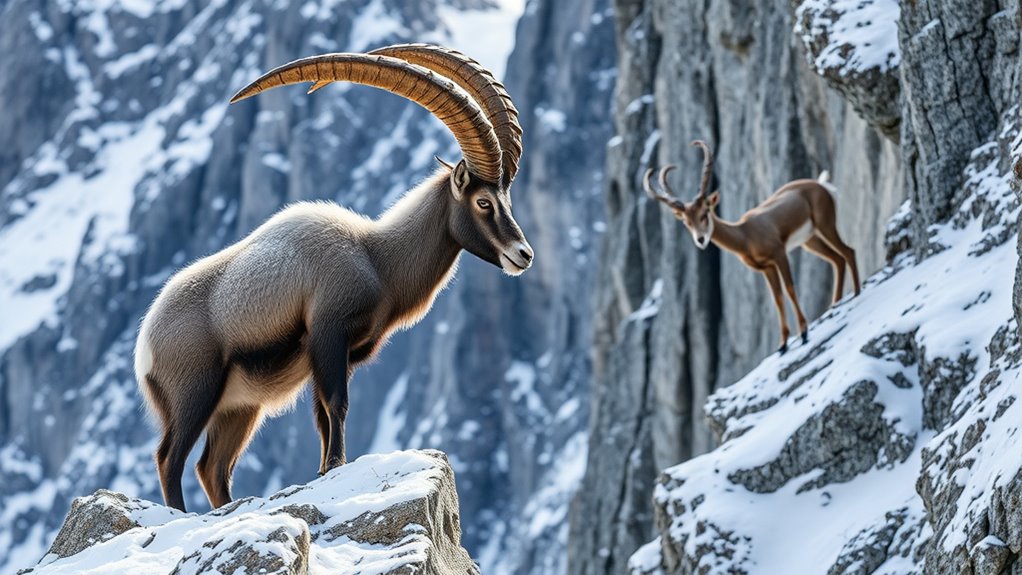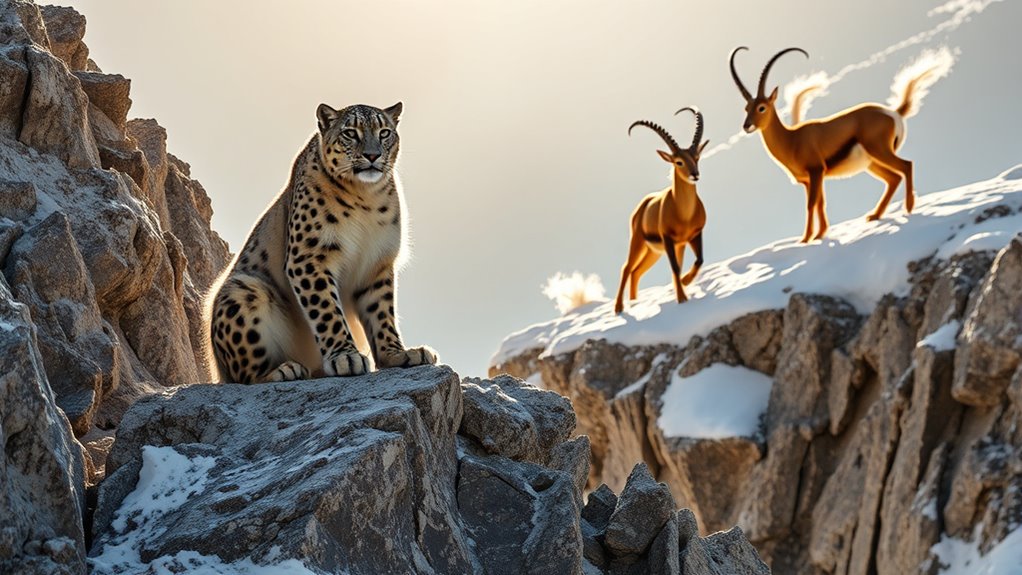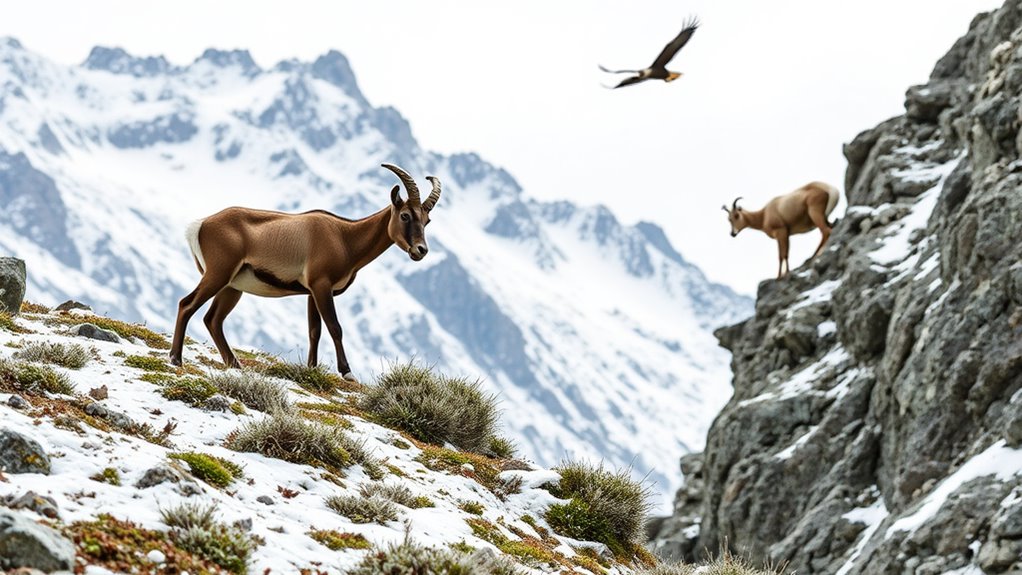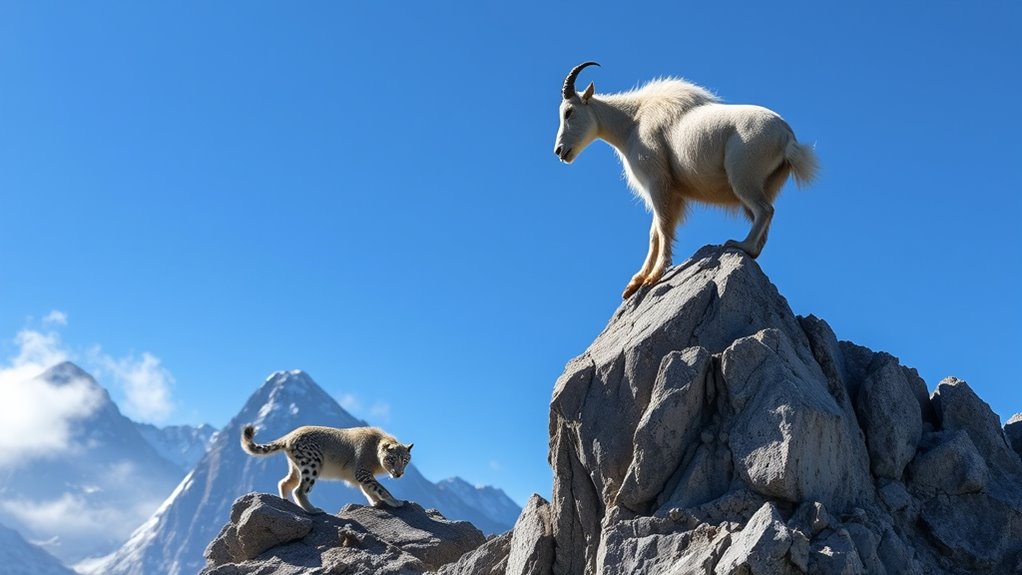Mountain animals have unique adaptations to thrive in high-altitude environments. They've got thick fur, specialized hooves, and larger hearts that help them withstand harsh conditions. You'll notice behavioral strategies like hibernation and migration, which conserve energy and enhance survival. Their diets are tailored to seasonal changes in food availability. Unfortunately, climate change is disrupting these adaptations, making survival more challenging. Keep exploring, and you'll discover even more fascinating insights about these resilient creatures.
Key Takeaways
- Snow leopards have thick fur and long tails to retain heat in cold mountain environments.
- Mountain goats utilize specialized hooves for enhanced traction on steep, rocky terrains.
- Himalayan yaks possess larger hearts and lungs to efficiently absorb oxygen at high altitudes.
- Mountain hares change fur color seasonally, providing effective camouflage against predators in varying environments.
- Behavioral adaptations like hibernation in marmots and seasonal migration in bighorn sheep optimize survival in harsh conditions.
Morphological Adaptations of Mountain Animals

When you explore the adaptations of mountain animals, you'll notice that their physical traits are finely tuned for survival in harsh environments.
For instance, snow leopards have thick fur and long tails that help retain body heat, essential for cold mountain climates.
Mountain goats possess specialized hooves that provide traction on steep rocks, enhancing their climbing abilities.
Mountain goats' specialized hooves enable them to navigate steep rocky terrains with remarkable agility and stability.
The Himalayan Yak showcases morphological adaptations with a large lung capacity and an enlarged heart, enabling efficient oxygen extraction at high altitudes.
Additionally, mountain hares exhibit seasonal fur color changes, turning white in winter for snow camouflage and light ginger in summer to blend with rocky terrains.
These adaptations demonstrate how animals have adapted to thrive despite the challenging conditions they face.
Functional Adaptations for High Altitudes

As mountain animals navigate the challenges of high altitudes, they rely on remarkable functional adaptations to thrive in thin air. Animals like yaks have larger hearts and lungs, enhancing their oxygen absorption and circulation in thinner atmospheres. These adaptations are essential for survival at higher elevations, where oxygen levels drop considerably.
Many mountain species also exhibit increased metabolic rates, generating body heat to withstand extreme weather during harsh winter months. Their efficient respiratory systems, featuring larger nasal cavities, maximize oxygen intake.
Additionally, mountain wildlife has adaptations to reduce water loss through urine, maintaining hydration in arid environments. Energy conservation strategies, like reduced activity during severe weather, help these animals cope with scarce food and other challenges in their extreme habitats.
Dietary Strategies in Harsh Environments

Though high-altitude environments present significant challenges, mountain animals have developed unique dietary strategies to make the most of their limited resources.
Mountain goats, for example, exhibit specialized dietary habits, feeding on specific plant species that thrive in harsh conditions. These herbivorous creatures adapt to seasonal food scarcity by consuming a diverse range of vegetation.
Mountain goats exemplify specialized feeding habits, thriving on diverse vegetation in harsh, seasonal environments.
During extreme cold, animals like alpine marmots rely on stored body fat and food reserves gathered during the brief growing season. The waxy leaf substances of alpine plants help retain moisture, essential for survival in dry spells.
Additionally, many mountain animals show seasonal feeding patterns, adjusting their diets according to the availability of food resources that fluctuate with climate and elevation.
Behavioral Adaptations for Survival

Many mountain animals have evolved remarkable behavioral adaptations to survive the extreme conditions of their environment. For instance, Himalayan marmots employ hibernation strategies, conserving energy for up to nine months during harsh winters.
Other species, like bighorn sheep, exhibit seasonal migration, moving to lower elevations in search of accessible food sources. As climatic conditions fluctuate, these animals adjust their foraging strategies, adapting to periods of scarcity by seeking out available vegetation.
Some mountain animals even engage in family group hibernation, maximizing warmth and safety together.
However, human encroachment has altered natural dietary patterns, pushing these animals to rely more on food waste. These behavioral adaptations are essential for thriving in the challenging mountain ecosystem.
Impact of Climate Change on Mountain Wildlife

Climate change considerably impacts mountain wildlife, creating challenges that threaten their survival. As temperatures rise, plant life is moving higher, disrupting established habitats and introducing new competitors and predators. This shift affects living organisms, like herbivores such as mountain hares and ibex, making foraging difficult due to harder snow layers.
Golden eagles struggle too; altered vegetation patterns hinder their hunting abilities, affecting their breeding success. Increased rainfall leads to habitat fragmentation, isolating animal populations and making them vulnerable to extinction.
Snow leopards face declining prey availability and retaliatory killings from livestock predation, worsened by climate-induced habitat changes. These interconnected issues highlight the urgent need to address climate change to protect mountain wildlife and their fragile ecosystems.
Frequently Asked Questions
What Are 3 Adaptations of a Mountain Lion?
Mountain lions have impressive adaptations that help them thrive in their rugged habitats.
First, their powerful hind legs let you leap up to 40 feet, making it easier to navigate steep terrains.
Second, their tawny fur provides excellent camouflage, helping you stalk prey unnoticed.
Finally, your keen eyesight and hearing allow you to hunt effectively, even in varying light conditions.
These traits make mountain lions formidable predators in their mountainous environments.
What Are the 5 Main Adaptations Animals Have?
When you think about animal adaptations, there are five main types you should consider.
First, physical adaptations, like body structures or fur, help animals survive in their environments.
Then, behavioral adaptations involve actions animals take, such as migration or hibernation.
Next, physiological adaptations refer to internal processes that enhance survival, like temperature regulation.
Camouflage helps with predator evasion, while reproductive adaptations guarantee species survival.
Each plays an essential role in how animals thrive.
What Are the Adaptations of Animals at High Altitudes?
"When the going gets tough, the tough get going."
Animals at high altitudes adapt remarkably to survive. They've got larger lungs and hearts to efficiently extract oxygen from thin air.
You'd notice their specialized hooves, offering excellent grip on rocky surfaces, while seasonal fur color changes help them blend into their surroundings.
Plus, their thick fur and higher metabolism keep them warm in extreme cold, allowing them to thrive in harsh mountain environments.
What Are the Adaptations of a Mountain Bear?
Mountain bears have several key adaptations that help them thrive in their rugged habitats.
You'll notice their thick fur, which keeps them warm in cold temperatures. Their large body size helps retain heat, too. They've got strong limbs and big paws for climbing steep terrains.
During winter, they hibernate to conserve energy when food is scarce. Plus, their omnivorous diet allows them to take advantage of the diverse food sources available around them.
Conclusion
To sum up, mountain animals showcase incredible adaptations that enable them to thrive in their harsh environments. They've evolved unique physical traits, developed specialized functions for high altitudes, and adopted clever dietary strategies. Their behaviors reflect an instinctual drive for survival, while the looming threat of climate change challenges their resilience. As you explore the wonders of mountain wildlife, remember that their survival depends on the delicate balance of nature—an intricate web that connects us all.










